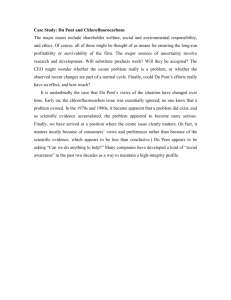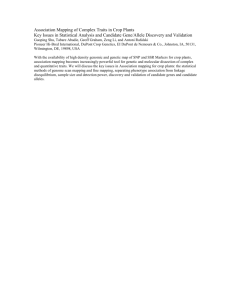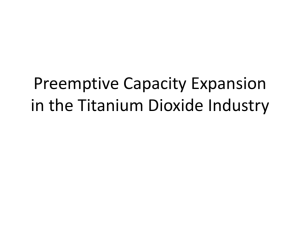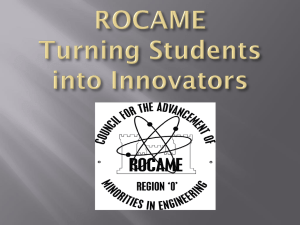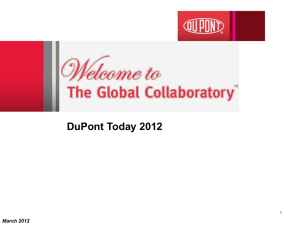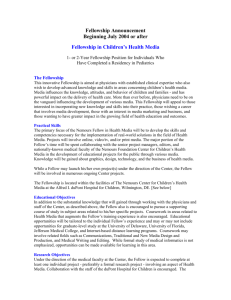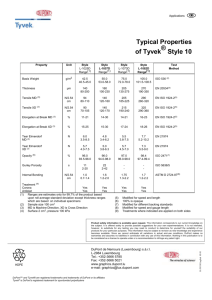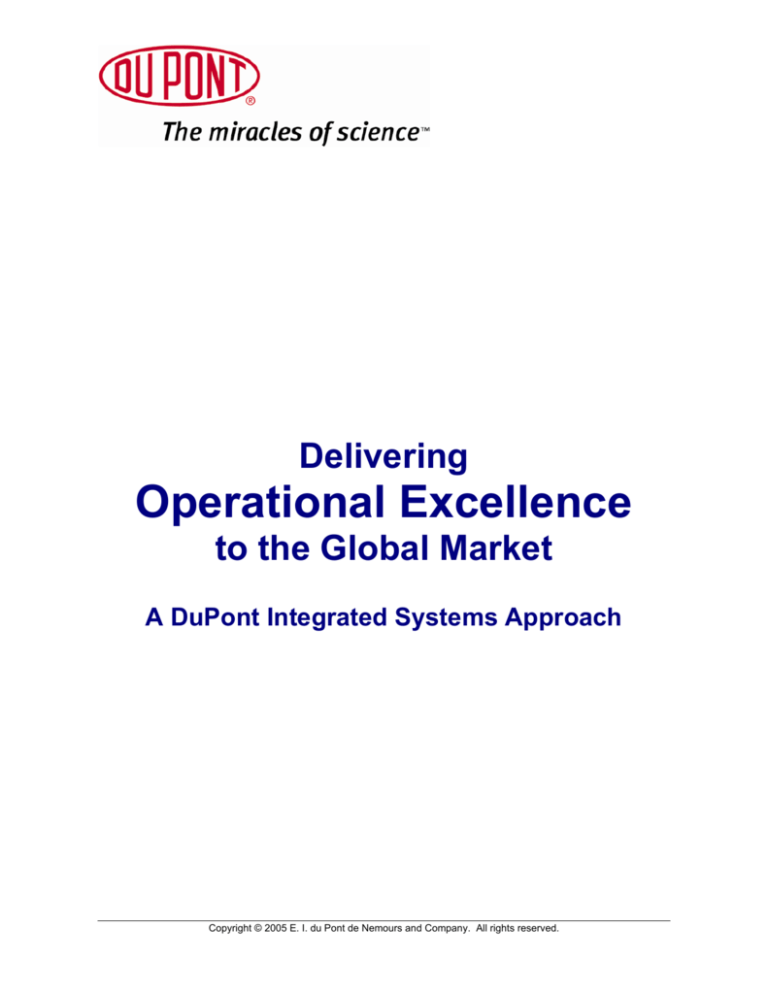
Delivering
Operational Excellence
to the Global Market
A DuPont Integrated Systems Approach
Copyright © 2005 E. I. du Pont de Nemours and Company. All rights reserved.
Contents
EXECUTIVE SUMMARY ............................................................................................ 1
OPERATIONAL EXCELLENCE OVERVIEW.............................................................. 2
THE DUPONT APPROACH TO OPERATIONAL EXCELLENCE.............................. 4
ASSET PRODUCTIVITY............................................................................................. 6
CAPITAL EFFECTIVENESS....................................................................................... 9
Facilities Engineering Process................................................................................. 9
OPERATIONS RISK MANAGEMENT....................................................................... 12
Seven Elements of Operational Risk Management ............................................... 14
Other Risk Management Consulting Expertise ...................................................... 16
ENGAGEMENTS DESIGNED TO MEET YOUR OBJECTIVES ............................... 18
DUPONT’S UNIQUE QUALIFICATIONS .................................................................. 19
A History of Sharing Expertise............................................................................... 19
Depth and Breadth of Expertise............................................................................. 20
CASE STUDIES........................................................................................................ 22
CASE STUDY 1..................................................................................................... 22
CASE STUDY 2..................................................................................................... 23
CASE STUDY 3..................................................................................................... 24
CASE STUDY 4..................................................................................................... 25
CONCLUSION .......................................................................................................... 26
Copyright © 2005 E. I. du Pont de Nemours and Company. All rights reserved.
EXECUTIVE SUMMARY
In today’s competitive global marketplace, excellence is not an option; it is essential
to success. For many businesses, the DuPont Operational Excellence (OE) model
can be the key to global business competitiveness. This document describes our
approach to helping our clients maximize their business results by applying DuPont
expertise, technology, and process knowledge.
DuPont’s Operational Excellence model helps our clients apply best practices with
respect to:
Asset Productivity
Capital Effectiveness
Operational Risk Management
Our structured approach can bring to your organization the experience of a 200-yearold corporation that has operated thousands of different processes in hundreds of
manufacturing locations in over eighty countries around the world. DuPont’s
scientists and engineers have perhaps the broadest experience base of any
consulting firm in the world in increasing the efficiency of manufacturing processes.
The following pages provide the information needed to take the first vital steps
toward achieving Operational Excellence, including an outline of the process,
specifics about DuPont areas of expertise, and detailed case studies showing
how the process has worked for other organizations – and thus could work for
you. The next step is up to your organization. We look forward to working with
your team in making the journey to Operational Excellence.
Copyright © 2005 E. I. du Pont de Nemours and Company. All rights reserved.
1
OPERATIONAL EXCELLENCE OVERVIEW
Why is Operational Excellence so important to the success of your business in the
global marketplace today? Here is what the experts say:
“Operations must become a, if not the, primary marketing tool in the firm’s
arsenal. Quality, maintainability, responsiveness, flexibility and the length of the
innovation cycle are controlled by the factory.”
(Tom Peters, Thriving on Chaos)
“Operations is more than the bricks-and-mortar decisions—the amount of
production capacity, the kind of production equipment, and the location of the
equipment. Management policies and systems determine HOW WELL the bricks
and mortar perform and therefore HOW COMPETITIVE they are.”
(Robert H. Hayes, Seven C. Wheelwright, and Kim B. Clark, Dynamic Manufacturing)
Operational Excellence (OE) is an integrated management system developed by
DuPont that drives business productivity by applying proven practices and
procedures in three “foundation blocks” – Asset Productivity, Capital
Effectiveness, and Operations Risk Management.
The OE management system gives a company the benefits of lower costs, increased
efficiencies, fewer injuries, maximum sustainable returns on operating assets, and an
enhanced competitive position.
Our integrated OE management system can be applied to existing facilities, new
facilities, and facility expansions. OE gives an organization these advantages:
•
•
•
•
•
Strategic clarity about your mission, objectives, and organizational
expectations;
A culture of Operational Excellence;
Best practices in process architecture;
A well-orchestrated improvement journey; and
Superior organizational alignment and execution.
Taking the journey toward achieving Operational Excellence typically begins with
making an initial step-change improvement, followed by a continuum of
incremental enhancements. Installing a culture of Operational Excellence results in
significant and sustained competitive advantage.
Copyright © 2005 E. I. du Pont de Nemours and Company. All rights reserved.
2
A study by the Board of Manufacturing and Engineering Design (formerly the
Manufacturing Studies Board) of the U.S. National Research Council showed that
companies that effectively implemented world-class manufacturing systems achieved
tremendous improvements in asset productivity performance.1
•
•
Increase in product quality
Increase in manufacturing productivity
100–400%
40–70%
(quantity/person)
•
•
•
Increase in manufacturing capacity
Reduction in in-process inventory
Reduction in overall product introduction time
15–25%
30–60%
30–60%
At DuPont, we have experienced these levels of impressive, measurable results.
The application of OE best practices has also given us outstanding performance in
low-cost risk management (seven times better than the industry average2) and a
10- to 15-percent improvement in overall capital effectiveness3.
1
“Toward a New Era in U.S. Manufacturing: The Need for a National Vision.” The National Academies Press, 1986, p. 119.
For opportunity for comparable improvement, see gaps between upper quartile and average, 2001 Industry Week census of
manufacturers.
2
2001 Benchmark Survey of the Risk and Insurance Management Society, Inc.
3
As benchmarked by Independent Project Analysis (IPA).
Copyright © 2005 E. I. du Pont de Nemours and Company. All rights reserved.
3
THE DUPONT APPROACH TO
OPERATIONAL EXCELLENCE
Because we believe that excellence among all is best for all, DuPont offers
management-consulting and implementation services to help other companies
achieve sustainable improvements in productivity. Both DuPont and our clients
realize such results through our change-management process, which involves:
•
•
•
•
•
Assessing a client against established benchmarks and best practices;
Identifying areas for improvement with corresponding return on
investment;
Aligning the organization with the reason for change and a vision of the
future state;
Implementing appropriate processes and practices to realize the
benefits; and
Providing a continuous improvement framework for sustainability.
To help you achieve Operational Excellence, we combine the best management
processes, globally recognized technologies and technologists, Six Sigma
methodology, and a proven culture-change model to provide an integrated solution.
Our consultants customize a client-specific approach that leads to sustainable
competitive advantage. We facilitate the transfer of knowledge and capabilities by
offering personal coaching and mentoring that ensures ongoing improvements. We
don’t just identify problems and recommend solutions; we actively help our clients
to fix what is broken and make the changes needed so it does not break again.
We recognize each client’s uniqueness, while providing a continuum of closed-loop,
systematic approaches that range from strategic design to process technology.
Clients gain immediate benefit by having access to our 200 years of manufacturing
experience and expertise in Operational Excellence, 100 years of engineering
innovation and systems integration, and more than 30 years of experience in
providing consulting and training services through our DuPont Safety Resources
(DSR) business.
Our seamless transfer of knowledge and side-by-side implementation assistance
maximizes results in the shortest time. Our professional staff brings decades of
operational experience in a multitude of industries. Their expertise in providing
program analysis and consulting services for public and private entities was
developed through hand-on improvement of DuPont’s manufacturing operations – a
unique qualification that lets us help clients achieve similar results.
Copyright © 2005 E. I. du Pont de Nemours and Company. All rights reserved.
4
Our Operational Excellence system of service is based on the following three
foundation blocks:
•
•
•
Asset Productivity
Capital Effectiveness
Operations Risk Management
Each of these foundation blocks contains a number of specific management system
elements – 21 in all – that we apply to each client’s situation as necessary. The
three foundation blocks are described in detail on the following pages.
We can perform at multiple levels – from very concise to very broad, with a range of
services as basic or detailed as required. Using multi-component analysis, we
identify gaps in operations strategy, deployment, and execution.
We then develop a business case for improvement. This becomes the platform for
launching improvement teams under the guidance of subject-matter experts, and
leads to the development of a plan for sustaining the gains and continuous
improvement.
OPERATIONAL
OPERATIONAL EXCELLENCE
EXCELLENCE
Integrated
Integrated Management
Management Systems
Systems
Organization
Organization -- Roles
Roles &
& Responsibilities
Responsibilities -- Standards
Standards
Guidelines
Guidelines -- Practices
Practices -- Procedures
Procedures -- Audits
Audits
Asset
Asset Productivity
Productivity
Maintenance and Reliability
Systems
Manufacturing Capacity
Energy Optimization
Facilities Infrastructure
Mechanical Integrity
Product Quality and Process
Control
Operations
Operations
Risk
Risk Management
Management
Capital
Capital Effectiveness
Effectiveness
Business Planning
Facility Planning
Project Planning
Project Implementation
Start-up and Initial Operations
Value-Improving Practices
Contractor Effectiveness
Shutdown/Turnaround Planning
Technical and Facility Safety
Systems
Electrical
Fire and Explosion
Environmental
Product Stewardship
Distribution
Occupational Health and
Industrial Hygiene
DuPont
DuPont Technology
Technology and
and Science
Science
Copyright © 2004 E. I. du Pont de Nemours and Company. All rights reserved.
Copyright © 2005 E. I. du Pont de Nemours and Company. All rights reserved.
5
ASSET PRODUCTIVITY
Asset Productivity is a process for extracting the maximum value from a
manufacturing asset base (people, materials, and investment), resulting in increased
cost productivity.
Our clients increase their asset efficiencies and realize increased profitability through
our proven change processes and by implementing our world-class workmanagement processes, results-oriented key-performance indicators, and industryrecognized best practices/standards.
These Asset Productivity continuous-improvement processes have given DuPont a
visible competitive advantage – a 3% to 5% yearly increase in cost productivity
globally over the past 10 years.
To ensure sustainable results, we treat each client engagement as a project. The
DuPont Asset Productivity delivery model is a five-step process with a
methodology aligned with both Six Sigma and the DuPont Capital Process:
1. Business Level Analysis – understand “what” is happening (GAP analysis).
2. Assessment – discover “why” things are the way they are (begin the change
process).
3. Consensus/Implementation Planning – develop “how” to make a
change/impact (chartering for action).
4. Implementation – put the plan into action (realization).
5. Sustaining/Control Plan – keep the gains (build on success).
As a practice, Asset Productivity is divided into six elements that instill the discipline
necessary for improving and sustaining manufacturing competitiveness.
1. Maintenance and Reliability Systems – An integration of functional disciplines
combining technology, work-management systems, and change processes, applied
in a systematic way, to lower unit maintenance costs by 10% to 20%, by finding and
resolving the root causes of unacceptable process reliability and poor equipment
performance.
Examples of delivery components:
•
Work-managing Processes
•
Managing Storeroom (MRO) Supplies Effectively
•
Reliability-Focused Maintenance
•
UPbase® Uptime Measurement Software
•
Preventive/Predictive Maintenance Strategies
Copyright © 2005 E. I. du Pont de Nemours and Company. All rights reserved.
6
2. Manufacturing Capacity – A process focused on improving operations by
15% to 25% through increased throughput, cycle-time reduction, eliminating
bottlenecks, and improving work flow by modeling and analysis capabilities.
Examples of delivery components:
•
Material and Product Flow Analysis (MSA)
•
Continuous Flow Manufacturing (CFM/LEAN)
•
Industrial Ergonomics
•
Warehouse/Distribution Analysis
•
Manufacturing Systems Simulation/Visualization
3. Energy Optimization – Improving energy efficiency, safety, reliability, cost, and
operability for the current fixed asset base by applying superior technology, creating
typical savings of 2% to 3% savings in six months and 10% within two or three years.
Sustainability evolves from applying best practices, audits, and transferred
knowledge, resulting in reducing the infrastructure “footprint” and liberating funds for
other mission-critical initiatives.
Examples of delivery components:
•
Steam/Dowtherm Generation
•
Electrical Power Distribution
•
Refrigeration
•
Cooling Towers
•
Heating, Ventilating, & Air Conditioning (HVAC)
4. Facilities Infrastructure – Re-establishing asset integrity to handle the constant
pressures to increase earnings and reduce costs that can create a culture in which it
becomes the normal practice to defer maintenance. The DuPont Infrastructure
Maintenance Audit (IMA) Process creates a timely, systematic way to help minimize
the maintenance costs associated with aging facilities.
Examples of delivery components:
•
Groundwater Protection – trenches/sumps/dikes, tank foundations, sewers
•
Structural Integrity and Architectural Components
•
Transportation Systems – roads/pavements, railroads
•
Power/General Services – PG&S equipment & systems, electrical power
equipment & systems; HVAC equipment & systems, service piping
•
Materials – coatings & linings, plastics & elastomers, insulation, fireproofing
•
Life Safety Systems
Copyright © 2005 E. I. du Pont de Nemours and Company. All rights reserved.
7
5. Mechanical Integrity – A component of both Process Safety Management (PSM)
and Risk Management Programs (RMP) that integrates technologies to create a
program that focuses on regulatory compliance and on reducing emissions and
failures. It is reliability-based and establishes a framework to rank mechanicalintegrity activities.
Examples of delivery components:
•
Materials of Construction Selection, Specification, and Fabrication
•
Equipment and Piping Nondestructive Testing and Condition Assessment
•
Maintenance and Reliability Predictive/Preventive Maintenance
•
Process Safety Management
6. Product Quality and Process Control – Creates manufacturing processes of
sustainable competitive advantage through improved quality (100% to 400%) and
yields, by applying our Process Dynamic Analysis, Control Strategy Synthesis,
Design for Process Operability, Application of Statistical Methodologies, and Quality
Improvement Practices.
Examples of delivery components:
•
Dynamic Simulation (TMODS™)
•
Performance Surveyor™
•
Lab Feedback Proportional Integral Controllers
•
Process Operability Analysis
•
Advanced Statistical Process Estimation and Control Tool (ASPECT)
•
Six Sigma and Applied Statistics
•
Quality Management
Copyright © 2005 E. I. du Pont de Nemours and Company. All rights reserved.
8
CAPITAL EFFECTIVENESS
DuPont has consistently demonstrated that Capital Effectiveness can reduce
annual capital budget by 10% to 15%, or increase yield from an existing capital
budget by 10% to 15%. We have developed a well-defined Facilities Engineering
Process, identified the most critical steps in that process, created best practices to
explain how to execute the critical steps, and developed assessment tools to
measure how well those steps have been executed.
These processes and tools represent our cumulative know-how from 100 years of
executing some of the most significant capital projects in the world. Based on the
ratings of all Independent Project Analysis (IPA) performance parameters, DuPont is
the benchmark for the industry and the acknowledged global leader in project
management/execution.
During a client engagement, our experts first perform a detailed assessment of the
client’s capital-management and execution process.
Next, using assessment results, we propose a capital-effectiveness improvement
program that includes the following:
•
•
•
•
•
•
•
Training in our Project Process Methodology, including how to apply/adapt
this methodology to the client’s process.
Training in how to be an effective Project Team Leader.
Training in selecting and applying value-improving practices for cost and
schedule effectiveness.
Applying selected value-improving practices to actual client projects.
Detailed review of more than 20 capital best practices, including generic
templates that allow clients to develop their own set of best practices.
Specific practices and techniques to help the owner representative manage
design and construction contractors.
Techniques for managing an overall capital program, including project
prioritization, capital allocation, and budget control.
Finally, we help the client execute the capital-effectiveness improvement program
and put sustaining processes and practices in place to realize a 10% to 15%
reduction or improved use of the client’s capital budget.
Facilities Engineering Process
The DuPont Facilities Engineering Process has eight elements:
Copyright © 2005 E. I. du Pont de Nemours and Company. All rights reserved.
9
1. Business Planning – Ensures that the business objectives are recorded,
understood, and accepted by all who contribute to the project.
2. Facility Planning – Transforms business objectives into project objectives
and a project capital budget.
3. Project Planning –Transforms project objectives into a production design
basis and authorization estimate.
4. Project Implementation – Launches production design, procurement, and
construction.
5. Start-up and Initial Operations – Begins plant commissioning, operations,
and maintenance.
6. Value-Improving Practices (VIPs) – Uses applicable VIPs to improve cost,
schedule, and operability.
7. Contractor Effectiveness – Identifies and completes contracted work for best
value.
8. Shutdown/Turnaround Practices – Creates more effective shutdowns with
longer intervals between shutdowns, while increasing Uptime.
Global
Customer
Needs &
Requirements
Business
Objectives,
Capital
Forecasts
Business
Planning
Production
Des Basis,
CAC,
Project
Auth.
Project
Basis,
Capital
Budget
Facility
Planning
Project
Planning
Products That
Continuously
Meet Global
Customer Needs
& Requirements
Better Than All
Competitive
Products
Competitive
Facility
That Meets
Business
Needs
Project
Implementation
Facility
Operation
DuPont Facilities Engineering Process
We have developed additional capital-effectiveness tools in our Facilities Engineering
Process, including:
•
•
•
Project gate-keeping methodology.
“No change” project execution.
Readiness-to-operate validation.
Copyright © 2005 E. I. du Pont de Nemours and Company. All rights reserved.
10
The benefits of our Facilities Engineering Process include:
•
•
•
Best practices for business, facility, and project planning in the industry,
resulting in firm scope of work for projects.
Controlled project cost (to +/–10%).
Experience of a benchmarked leader in capital project execution.
Copyright © 2005 E. I. du Pont de Nemours and Company. All rights reserved.
11
OPERATIONS RISK MANAGEMENT
Understanding and controlling risks can provide substantial benefits to the well-being
of a company’s employees, contractors, finances, and public image: fewer injuries,
lower emissions, and reduced claims expenditures. Conversely, failure to properly
manage risks can have severe negative consequences.
We are uniquely qualified to offer consulting services in the area of risk management.
As shown below, DuPont integrated systems have made us the leader in managing
risk, with costs at seven times below industry averages.
Who Has the Lowest Cost of Managing Risk?
Du Pont’s Performance is ~7x better than industry averages
and ~3x better than chemical peer group
$ Direct Spend/$1,000 Revenue
3.00
2.50
2.00
1.50
1.00
o'
s
y
ve
M
Su
r
,&
IM
S
G
as
R
&
64
0
il
&
rg
y,
O
En
e
on
ic
ct
r
-
C
in
in
g
p
as
ic
al
Eq
ui
tie
s
c.
U
til
i
is
El
e
M
El
ec
tr
-G
fg
M
al
s
et
M
ot
el
s
Entitlement
H
-E
le
ct
Tr
an
s
U
tie
s
D
uP
on
t
til
i
-
ric
po
rta
ti o
n
,H
Lu
Se
os
m
rv
br
p.
.,
,R
Fu
e
al
rn
itu
Es
re
ta
te
,P
ap
e
A
r,
gr
&
ic
Pa
ul
ck
tu
re
.
&
To
ba
cc
o
C
he
m
ic
R
al
ub
s
be
r,
Pl
as
tic
s
0.50
Source: 2001 RIMS Benchmark Survey, property damage & business interruption*
Our Operations Risk Management offering is an integrated management system
that expands on our proven safety-management model to encompass process-safety
management (PSM) and behavioral safety in the following seven elements:
1. Technology and Facility Safety Systems
2. Electrical
3. Fire and Explosion
Copyright © 2005 E. I. du Pont de Nemours and Company. All rights reserved.
12
4.
5.
6.
7.
Environmental
Product Stewardship
Distribution
Occupational Health and Industrial Hygiene
We help clients implement sustainable continuous-improvement processes to
manage risk in each of these elements through four main process areas:
assessing; envisioning and managing; planning; and implementation.
Continuous Improvement Cycle
Assess
Management
audits (e.g. FELT
leadership), 1st
and 2nd party
audits, leading and
training metrics.
Envision
A management
responsibility to
develop goals and
objectives;
approve KPI and
COT.
Plan
Analyze
assessment data,
track progress,
and develop KPI
and COT for
management
approval.
Implement
Implements COT
through the line
organization;
tracks progress
and reports to
management.
KPIs = Key performance indicators (e.g. metrics; FELT)
COTs = Critical Operating Tasks
FELT Leadership = from “feeling”; direct interaction
between leadership and the entire organization (top to
bottom)
The process starts with assessments, audits, and metric analysis to understand the
current state as compared to regulations, industry standards, corporate policy,
improvement opportunities, and other key performance indicators (KPIs), based on
client input. It then moves to developing management goals and objectives and
defining the organizational roles and responsibilities to accomplish these.
We then help put systems in place to track and analyze performance and other
metrics (KPIs), and to develop Critical Operating Tasks (COTs) based on these
metrics, goals, and objectives. Management agrees to the COTs and their
completion dates, and assigns responsibility for these to specific individuals.
We will train client resources, provide protocols, and assist with assessments,
developing metrics and tracking systems, data analysis, prioritizing improvements,
and implementing the COTs, which will address the full range of issues identified in
the continuous-improvement process.
Copyright © 2005 E. I. du Pont de Nemours and Company. All rights reserved.
13
Seven Elements of Operational Risk Management
1. Technology and Facility Safety Systems – We put our world-class reputation for
Safety/Health/Environment (SHE) expertise to use in developing management
systems and processes for manufacturing facilities, office buildings, laboratories,
infrastructure, and other facilities. These include organization, roles/responsibilities,
standards/guidelines, processes/procedures, and tools. Our experts define what
clients need to do, provide coaching in how to do it, and help implement to improve
performance. The effort starts with an assessment to understand client systems and
performance and develops recommendations for improvement.
Examples include:
•
•
•
•
Process Hazards Analysis
Standards and Guidelines
Process Safety Management
Implementation Assistance
Continuous Improvement
Process
•
•
•
•
•
Management Commitment and
Responsibility
Facility Siting Studies
Inherently Safer Processes
Emergency Response Planning
Integrated SHE Organization
2. Electrical – We have provided industry leadership to develop improved practices
and procedures, including management systems, tools, training, and experience, to
control the risk of electrical injuries at manufacturing sites, such as controlling
electric-arc flash fires. We will assess your processes and systems and develop an
improvement program.
Examples include:
•
•
•
Electrical Safety Training and
Consultation
Incident Investigations
Audits Using DuPont
Protocols
• Electrical Safety
Guidelines
• Short Circuit Studies
• Time/Current Coordination
• Arc-Flash Hazards
3. Fire and Explosion – The SHE management system provides the framework,
processes, procedures, tools, and skills needed to understand the risks, identify
improvement opportunities, and successfully manage the risks from fires and
explosions. We help clients ensure that systems are in place to prevent, protect, and
respond to fire and explosion events, using the state-of-the-art tools to identify key
risks using process-hazard review and consequence analysis. We help you establish
standards and guidelines; assess your systems, processes, and performance; and
develop recommendations for improvement.
Copyright © 2005 E. I. du Pont de Nemours and Company. All rights reserved.
14
Examples include:
•
•
•
•
Fire and Explosion Incident
•
Investigation
•
Fire and Explosion Modeling,
•
Detection, and Suppression
•
Fire Safety Audits
Fire Safety Management Systems
Fire Safety Training
Life Safety
Occupant Notification and Egress
Emergency Preparedness and
Response
4. Environmental – We also use the SHE management system to provide the
framework for additional tools in identifying risks and developing solutions to
environmental risks. This work uses the regulatory framework of the facility and
addresses air, water, and solid-waste issues.
Examples include:
•
•
•
•
Environmental Permitting
Environmental Solutions
Environmental Management
System Assessment
Air Dispersion Modeling
• Exposure/Risk Assessments
• Water-Quality Treatment
• Ground Contamination Remediation
Planning
• Solid-Waste Management
5. Product Stewardship – We help our clients ensure that all involved understand
the risks of products and manage them properly. This addresses key areas such as:
•
•
•
•
Senior Management Support
Internal Communications
Product Review Systems
Risk Characterizations and
Risk Management
• Systems for Training and Refreshing
R&D Systems
• Joint Ventures
• Sustainable Growth Initiatives
• Standards and Guidelines
6. Distribution – We help clients understand and manage distribution risks,
to ensure that proper tools, practices, and training are in place for distributing
hazardous materials. Key aspects include understanding and meeting regulatory
requirements, ensuring a properly trained workforce, and inspecting and auditing
facilities.
Examples include:
•
•
•
Regulatory Training
Standards and Guidelines
Risk Assessments
• Carrier Safety
• Emergency Preparedness
Copyright © 2005 E. I. du Pont de Nemours and Company. All rights reserved.
15
7. Occupational Health and Industrial Hygiene – We will help our clients develop,
document, and implement Occupational Health programs to protect people from the
harmful effects of chemical, physical, and biological hazards, providing the systems
and technology vital to identify and manage risks and assess performance.
Examples include:
•
OH Injury and Illness
Reporting, Classification,
Investigation, and
Documentation
• OH Roles, Responsibilities,
and Accountabilities
• OH Records and Communication
• Metrics of OH Management
• OH Audit Protocols
• Medical Programs for
Fitness Duty, Surveillance,
and Emergency Care
• Effective Wellness Programs
We use a full range of techniques to help clients understand risks and develop
effective mitigation measures. These include qualitative, semi-quantitative, and
quantitative analyses using state-of-the-art proprietary and licensed tools.
We also offer access to a wide variety of training courses in topics such as fire
protection, fire-safety management, electrical-safety management, biotech-safety and
-security management, environmental-risk management, product-stewardship
management systems, product liability, and ergonomics.
Other Risk Management Consulting Expertise
DuPont also provides consulting expertise in other risk-management areas:
Supply Chain – We help the supply-chain team identify and understand key
vulnerabilities and concerns, using our expertise in modeling, alliances, and
substitution to drive down cost. We help clients optimize inventory – amount
and location – to balance storage costs, customer service, and public/
environmental risk factors.
Examples include:
•
•
Assessment and Benchmarking • Optimization Tools – MIMI®
Simulation Software –
• SAP Supply Network Planning
®
®
Promodel , iGraphics-Process
Copyright © 2005 E. I. du Pont de Nemours and Company. All rights reserved.
16
Crisis Management – We provide the tools, training, and experience to help
put the systems in place that you need to be prepared to respond at the
corporate level when the unexpected happens – loss of manufacturing
facilities, transportation incidents, environmental incidents, financial incidents,
product-liability incidents, kidnappings, loss of key corporate officers, etc.
Examples include:
•
•
•
Assessment of Current Program
Standards and Guidelines
Development of Corporate Principles
Copyright © 2005 E. I. du Pont de Nemours and Company. All rights reserved.
17
ENGAGEMENTS DESIGNED TO MEET YOUR OBJECTIVES
DuPont designs engagements to meet four client objectives in terms of operational
costs – whether there is a need to change, what the future will look like, a plan
for change, and ways to secure and sustain the benefits of change.
Do I need to change? Create a view of a Create the plan for Secure and sustain the
future state
change
benefits of change
Assessing
Assessing
Visioning
Visioning
Planning
Planning
Implementation
Implementation
Project Management
Management
Project
Communications
Communications
Our consulting approach provides the framework to perform any combination of these
engagements. Assess, Envision, Plan, and Implement are sequential steps, while
Project Management and Communications occur in parallel throughout the
engagement.
•
•
•
•
•
•
Assessments focus on characterizing the current state of the client’s
operational excellence systems.
Envisioning drives commitment by understanding a client’s willingness to
embrace our approach.
Planning focuses on tailoring the implementation model to the client.
Implementation carries out the plan to secure the benefits the client
seeks.
Project management lets teams perform their work and track progress.
Communication enables all involved to share techniques and ensures
continued success over time.
Copyright © 2005 E. I. du Pont de Nemours and Company. All rights reserved.
18
DUPONT’S UNIQUE QUALIFICATIONS
A History of Sharing Expertise
As one of the oldest continuously operating industrial enterprises in the world,
DuPont has unsurpassed experience in engineering processes, operational
discipline, and safety performance. Our competitors and customers have long
recognized our methodologies and technical resources as critical assets in creating
the ideal foundation for a continuous improvement process of Operational
Excellence.
Over the past 100 years, DuPont Engineering has given our preferred clients access
to this wealth of knowledge/experience for their own competitive advantage. In the
early 1970s, we began to make one segment of our Operational Excellence portfolio
(safety) available to the public, in the form of training programs and consulting
services. In response to customer requests, we gradually expanded that offering to
include our expertise in contractor-safety management, ergonomics, and emergency
response.
Customers also began to express a desire for access to other key elements of our
Operational Excellence portfolio. When we began selling, licensing, and jointventuring product/process technology, customers and clients increasingly recognized
our competence in asset productivity, capital effectiveness, and operations risk
management. The global market wanted what was behind the DuPont processtechnology package because it produced competitive, profitable products while
demonstrating environmental stewardship.
As practiced at 150 DuPont manufacturing sites in 70 countries – and now available
to your organization as well – Operational Excellence has enabled a broad spectrum
of industries to consistently outperform in their respective markets.
When exported outside DuPont – whether in mining operations from Australia to
Canada to Colombia, public transportation systems in the United States, chemical
facilities in Asia Pacific, petrochemical complexes in Latin America, or coating
processes in India – our practices provide the sustainable, integrated solutions
needed today.
Copyright © 2005 E. I. du Pont de Nemours and Company. All rights reserved.
19
Depth and Breadth of Expertise
The DuPont “brain trust” behind our systems and processes consists of 600 DuPont
engineers and consultants representing the following engineering technologies:
Business, Investment, and Scheduling
- Estimating
- Cost Control
- Scheduling
Chemical/Process Engineering
- Heat, Mass, and Momentum Transfer
- Operations Research
- Particle Science
- Process Synthesis/Development
- Reaction Engineering
- Thermodynamics, Kinetics, and Mechanisms
Civil Engineering
- Infrastructure/Maintenance Assessments
Electrical and Instrumentation
- Control Systems
- Electrical Engineering
- Electrical Technology
- Instrument Engineering
Energy Engineering
- Energy Efficiency Audits
- Strategic Planning for Utilities (Risk-Based)
- Computer-Based Utilities Optimization
- Energy System Modeling
- Furnace and Fuel System Safety
- Combustion Technology and Control
- Refrigeration
- High Temperature Heat Transfer Systems
- Process, Laboratory, and Clean Room HVAC
- Indoor Air Quality
Facilities Construction and Support
- Contractor Safety
- Best Practices
- Pre-commissioning and Check-out
Copyright © 2005 E. I. du Pont de Nemours and Company. All rights reserved.
20
Industrial Engineering
- Manufacturing Systems
- Distribution
Mechanical Engineering
- Engineering Mechanics
- Maintenance Reliability Systems
- Mechanical Systems
- Process Equipment
- Rotating Machinery
Materials Engineering
- Materials Selection and Specifications
- Nondestructive Evaluations
- Corrosion and Wear Testing
- Fitness for Service Evaluation
- Equipment Physical Failure Analysis
Process Safety and Environmental
- Environmental Engineering
- Product Stewardship
- Explosion Hazards Laboratory
- Pollution Prevention
- Lead/Asbestos Abatement
- Hazard Remediation
- Process Safety and Fire Protection
- Occupational Health and Industrial Hygiene
- Explosion Engineering
Project Management
- Project Definition Leadership
- Facilities Engineering Process
- Procurement Processes
- Best Practice Discipline
- Project Implementation Excellence
Quality and Process Control
- Process Control
- Process Sensors and Analyzers
- Quality Management and Technology
Copyright © 2005 E. I. du Pont de Nemours and Company. All rights reserved.
21
CASE STUDIES
The following case studies provide insights into how the DuPont Operational
Excellence approach has helped client companies face, assess, and respond to
challenges in the global marketplace that were undermining their ability to compete
effectively. While these are by no means the only examples of our success in
applying the OE principles to the challenges of our clients, they offer a clear sense of
how we can help your organization achieve similar results.
CASE STUDY 1
Situation
PEMEX Gas (the national gas/petroleum company of Mexico) holds safety, health,
and the environment (SHE) as top management priorities. In its first five years of
work with DuPont, PEMEX achieved dramatic results in SHE performance, as well as
significant savings. The injury-frequency rate (injuries per 1 million man-hours
exposure) dropped from 4.86 in 1996 to 1.07 in 1997 and further to 0.60 in 2001.
The company set new goals to enhance its economic value by creating a business
culture of effective assets and defect elimination.
Solution
DuPont used the client’s excellent foundation in the SHE arenas to increase its asset
effectiveness, in part by implementing and training in using UPbase®, software
developed by DuPont to provide companies with detailed views of their
manufacturing units. The software identifies where and when production losses
occur so improvement efforts can be enacted effectively. The tool also utilizes
operations, maintenance, engineering, and business personnel to share information
between units, for integrated, sustained improvement processes.
Results/Client Benefits
•
Reduced injuries by 92% in two years.
•
Received recognition from the Mexican government for its accomplishments.
•
Received Industria Limpia certification by SEMANART, Mexico’s most
important government environmental-protection agency.
•
Enhanced employee morale by actively and visibly involving management and
staff in creating a safer, cleaner, and healthier work environment.
•
Established action plans to improve asset effectiveness, reliability, and Uptime
levels to greater than 90% by 2006.
Copyright © 2005 E. I. du Pont de Nemours and Company. All rights reserved.
22
NOTE: Because the following three case studies are
client-confidential, client/company names are not shown.
CASE STUDY 2
Situation
A multibillion-dollar global specialty-fibers business, committed to improvement,
faced the following conditions:
•
•
•
•
Technology advantages no longer offset competition.
Market prices were eroding.
Manufacturing costs had to be reduced.
Yields and quality required improvement.
Solution
DuPont applied the Operational Excellence approach to working with the client
company in developing a long-range plan focused on engineering, technology, and
operations. The client implemented these improved managing processes and
systems within the context of the plan.
Results/Client Benefits
•
First-pass yield (FPY) improved 15% over 10 years.
•
New technology reduced capital ($/kg) by 70%.
•
Conversion cost dropped 44% over 10 years.
100
FPY %
95
90
85
80
75
1990
1991
1992
1993
1994
1995
1996
1997
1998
1999
2000
Copyright © 2005 E. I. du Pont de Nemours and Company. All rights reserved.
23
CASE STUDY 3
Situation
A particular plant within a chemical commodity business wished to reduce variable
costs to improve its competitive position. Goals were to:
•
Improve uptime from being the least reliable plant (~70%) to 90%.
•
Maintain or improve SHE performance throughout the change process.
Solution
DuPont applied the Operational Excellence approach to enable a comprehensive
improvement process, with elements that addressed work processes, applied
technology, and site culture.
Results/Client Benefits
•
Improved reliability >18% to 91.5%.
•
Moved from ~70% to 90% uptime.
•
Reduced annual variable cost by $14MM.
•
Experienced no safety or environmental failures while implementing change.
%
Yield Improvement
95
90
85
80
75
70
65
60
55
50
Yield
1H96
2H96
1H97
2H97
1H98
2H98
Year
Copyright © 2005 E. I. du Pont de Nemours and Company. All rights reserved.
24
CASE STUDY 4
Situation
An inorganic-chemical products business wished to reduce manufacturing to improve
its competitive position. Specific goals were to:
•
Improve Uptime rate from 76% to 82%.
•
Improve maintenance and reliability (M&R) processes.
Solution
Using the Operational Excellence model, DuPont designed and helped install an
integrated M&R improvement project that focused on establishing better work
processes, upgrading systems, reducing costs, and improving reliability.
Results/Client Benefits
•
Reduced M&R spending by 21% (>$7MM/year).
•
Reduced the number of contractors.
•
Reduced downtime by 35% unscheduled and 9% scheduled.
•
Reduced OT from 12.2% to 6.6%.
•
Achieved project payback in less than one year.
M ainte nance & Re liability Spe nd
$35,000
Thousa nds $
$33,000
$31,000
$29,000
$27,000
$25,000
1999
2000
2001
2002
Copyright © 2005 E. I. du Pont de Nemours and Company. All rights reserved.
25
CONCLUSION
Clearly, the DuPont Operational Excellence system approach yields significant
improvements for our clients. We encourage your organization to become one of the
current era’s cutting-edge, successful members of the global marketplace by
incorporating our proven, results-oriented approach into your business planning and
activities.
We welcome the opportunity to further expand the ranks of the world’s effective
global organizations by sharing our expertise on your behalf.
Copyright © 2005 E. I. du Pont de Nemours and Company. All rights reserved.
26

